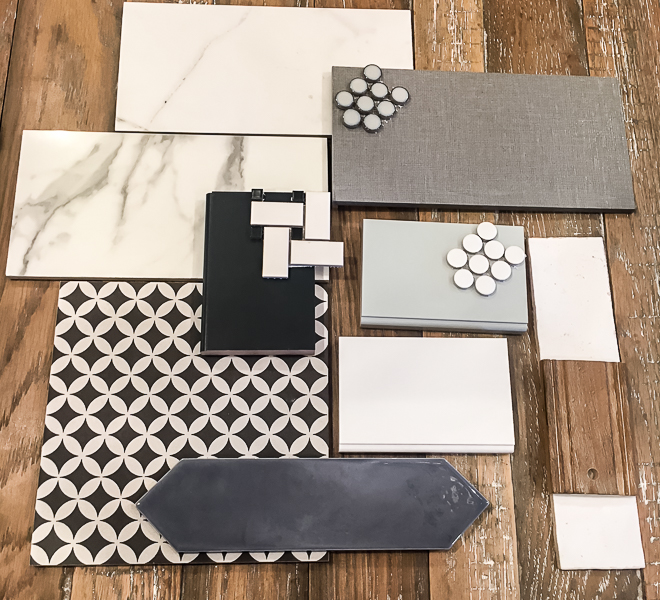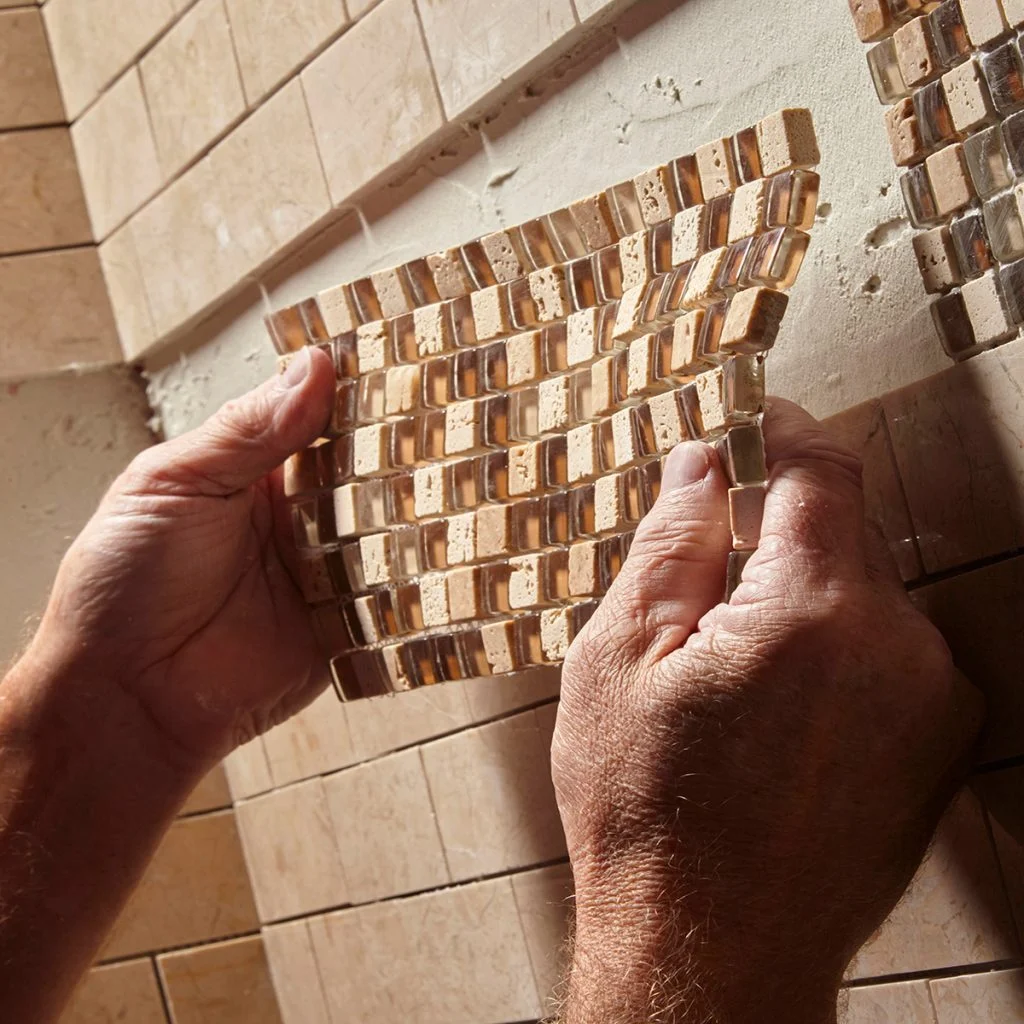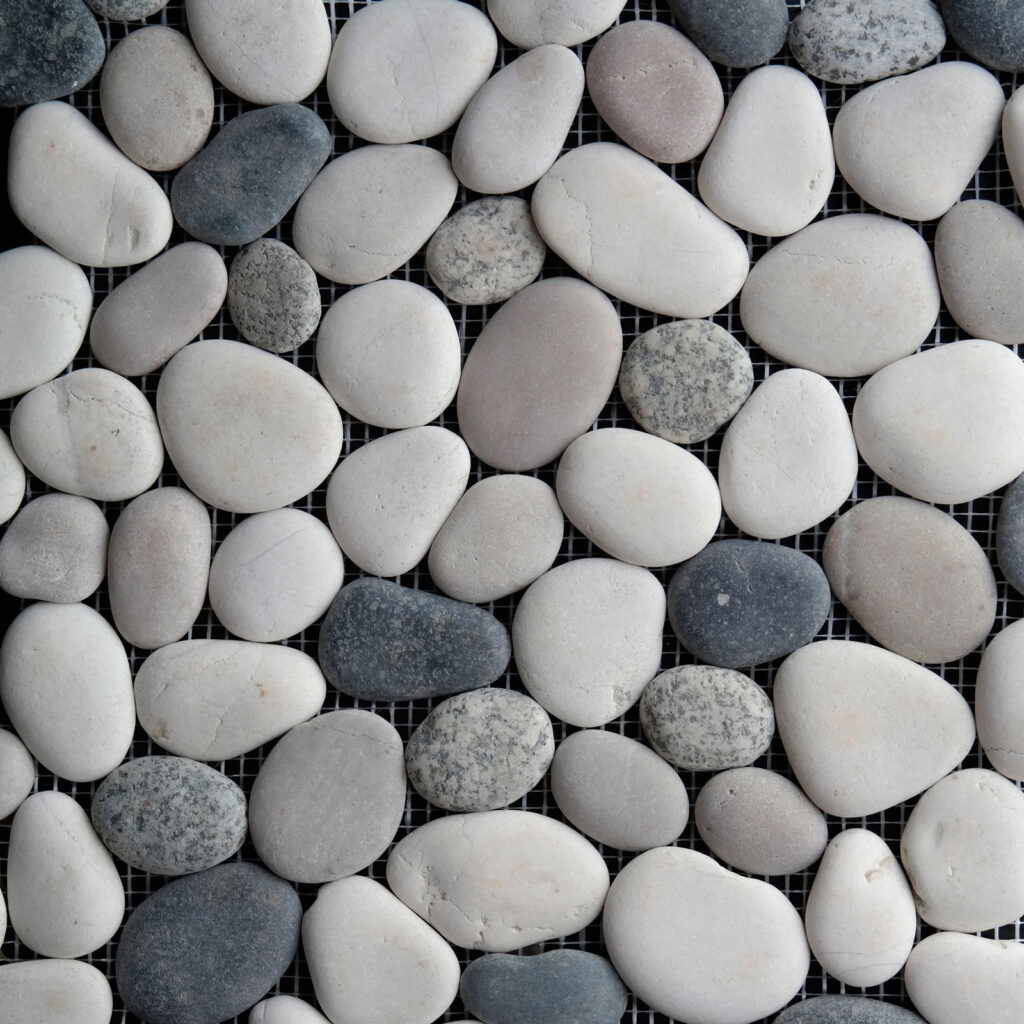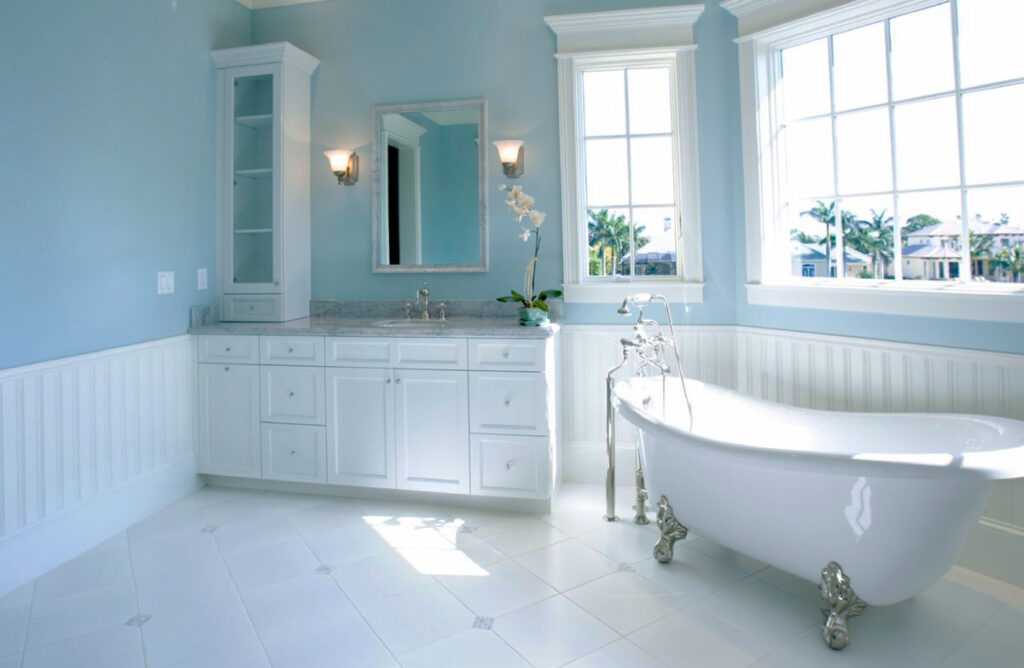Tile Material Breakdown: Porcelain vs. Ceramic vs. Natural Stone

When it comes to remodeling your bathroom or shower, choosing the right tile material can feel overwhelming. You’ve probably heard terms like porcelain, ceramic, and natural stone tossed around, but what’s the real difference between them? In this guide, we’re breaking it down so you can make the best choice for your bathroom remodel. Let’s dive into the unique qualities of each tile type—porcelain, ceramic, and natural stone—to help you decide which is the perfect fit for your project.
Porcelain Tiles: Durable and Versatile
If you’re looking for something incredibly durable and moisture-resistant, porcelain tiles might be the way to go. Porcelain is a type of ceramic tile, but it’s made from finer clay and fired at higher temperatures, making it denser and less porous. This makes it ideal for high-moisture areas like showers and bathrooms. You don’t have to worry about water seeping into the tile, which is a huge plus in wet areas.
One of the standout features of porcelain is its versatility. It comes in a wide range of styles, from classic stone-look tiles to sleek modern finishes. Whether you’re aiming for a minimalist spa-like bathroom or something more traditional, there’s a porcelain tile out there for you. Plus, its durability means you won’t need to worry about chips or cracks over time, so it’s a long-lasting investment.
The only downside? Porcelain can be a little trickier to install. Because it’s so dense, it’s tougher to cut, which might increase labor costs. However, if you’re aiming for a shower remodel that will last for years, the durability alone makes porcelain a great option.
Ceramic Tiles: Budget-Friendly and Stylish
Ceramic tiles, the more affordable sibling to porcelain, are a popular choice for many homeowners, especially if you’re working within a budget. While they aren’t as dense or moisture-resistant as porcelain, they still offer a wide variety of styles and finishes, giving you a lot of creative freedom.
One of the reasons ceramic tiles are so appealing is their ease of installation. They’re lighter and easier to cut than porcelain, which can help keep installation costs down. If you’re thinking of doing a smaller-scale remodel, like a backsplash or a decorative shower wall, ceramic might be the way to go. It’s a solid choice for areas that don’t experience as much water exposure as your shower floor or lower walls.
The downside of ceramic tiles is that they aren’t as resistant to water and wear over time. In areas that see a lot of moisture, like a shower floor, you might notice more wear and tear. However, for bathroom walls or decorative accents, ceramic tiles are a budget-friendly and stylish choice.
Natural Stone: Timeless Elegance and Luxury
For those of you looking to make a bold, luxurious statement, natural stone tiles offer timeless beauty. Materials like marble, travertine, and slate bring a unique texture and depth to your bathroom that’s hard to replicate with porcelain or ceramic. Each piece of natural stone has its own unique color and pattern variations, so no two tiles are ever exactly alike, adding a custom, one-of-a-kind look to your space.
But with that luxury comes a bit more maintenance. Natural stone is porous, which means it’s more prone to absorbing water and stains if not properly sealed. Regular sealing is required to protect the surface from water damage, especially in high-moisture areas like your shower. While this does mean a little more upkeep, many homeowners find that the elegance and natural beauty of stone are worth the extra effort.
Natural stone tiles also tend to be more expensive than porcelain or ceramic, both in terms of material and installation costs. But if you’re looking for a high-end finish that truly elevates your bathroom, the investment can be worth every penny.
Which Tile Is Right for Your Bathroom?
So, which tile should you choose for your remodel? It really comes down to your priorities. If durability and water resistance are at the top of your list, porcelain is a fantastic choice that will stand the test of time. If you’re looking for something budget-friendly but still stylish, ceramic tiles can give you plenty of design options without breaking the bank. And if you want a touch of luxury and don’t mind the extra maintenance, natural stone will add an unparalleled sense of elegance to your space.
Remember, the best tile for your bathroom is the one that fits both your style and lifestyle. Whether you go with porcelain, ceramic, or natural stone, each material brings its own strengths to the table (or in this case, the shower wall!). Take the time to think about how you’ll use the space and what kind of look you want to achieve.
Size Matters: Choosing Between Large-Format Tiles and Mosaics

When remodeling a bathroom, one of the first decisions you’ll face is the size of the tiles you want to use. Should you go for the sleek, modern look of large-format tiles, or is the intricate beauty of mosaics calling your name? It might seem like a small decision, but tile size can have a big impact on the overall vibe of your bathroom. In this guide, we’ll break down the pros and cons of large-format tiles and mosaics, so you can make an informed choice that suits your style and needs.
Why Large-Format Tiles Make a Big Statement
If you’re looking to create a clean, contemporary look, large-format tiles are an excellent choice. These oversized tiles—typically measuring 12×24 inches or larger—give your bathroom a sleek, spacious feel. Fewer grout lines mean fewer visual breaks, which can make the space feel more open and uncluttered. This is especially helpful in smaller bathrooms, where a seamless design can give the illusion of more room.
Not only do large tiles create a modern aesthetic, but they’re also practical. The fewer grout lines you have, the less time you’ll spend scrubbing them clean. That’s a win for anyone who dreads the maintenance of a bathroom. Plus, larger tiles can be quicker to install, since they cover more surface area at once. If you’re on a tight timeline, this might be a helpful bonus.
That said, large-format tiles do come with some challenges. They require a very level surface for installation—any bumps or imperfections in the floor or wall can cause the tiles to crack or sit unevenly. Additionally, cutting these tiles to fit around corners or fixtures can be more difficult, sometimes adding to the overall cost of installation. But if you want a streamlined, modern look with minimal maintenance, large-format tiles might just be the perfect fit for your bathroom remodel.
The Intricate Charm of Mosaics
On the opposite end of the spectrum, mosaics bring detail, texture, and personality to a bathroom. These small tiles, often measuring less than 2 inches per piece, come in sheets that are easy to work with, and their intricate patterns can make a big design impact. Whether you’re looking for something playful and colorful, or elegant and subdued, mosaics offer a lot of room for creativity.
Mosaics are especially popular for creating statement features, such as a backsplash, shower niche, or an accent wall. They can also be used on shower floors, as their smaller size provides more grip underfoot, reducing the risk of slipping. The design possibilities are endless—from classic hexagons and penny rounds to more elaborate, artistic patterns. If you want your bathroom to have a unique, handcrafted feel, mosaics are a great option.
However, the small size of mosaic tiles means you’ll have a lot more grout to deal with. More grout lines mean more cleaning and upkeep, especially in a wet, humid space like a bathroom. Mosaics also require a bit more time and precision during installation, which can add to labor costs. But if you’re looking to make a statement with your tile work and don’t mind the extra effort, the payoff is worth it.
Which Is Right for You?
So, should you go with large-format tiles or mosaics? Ultimately, it depends on the look and feel you’re trying to achieve in your bathroom. Large-format tiles are perfect if you’re going for a modern, minimalist vibe with easy upkeep. They create a spacious, streamlined appearance and reduce the number of grout lines, making cleaning a breeze. If you value simplicity and efficiency, these oversized tiles might be your go-to.
On the other hand, if you want to add a personal touch and bring more texture into your space, mosaics offer endless design possibilities. Whether you’re aiming for a bold accent wall or a detailed shower floor, mosaics give you the flexibility to play with colors, patterns, and textures. Just be prepared for a bit more maintenance, as those tiny grout lines will need some extra attention over time.
Mixing It Up: Combining Both for a Balanced Look
Still undecided? Why not have the best of both worlds? Many bathroom remodels successfully blend large-format tiles with mosaics to create a balanced, harmonious design. For example, you could use large tiles for the shower walls or bathroom floor, while incorporating mosaics in a feature wall or shower niche for added visual interest. This combination allows you to enjoy the practicality of large-format tiles, while still injecting a bit of personality with the mosaics.
A well-thought-out mix of tile sizes can bring both functionality and flair to your bathroom. The large tiles keep things clean and modern, while the mosaics provide that wow factor. It’s a great way to customize your space without overwhelming it with too many competing elements.
Slip Resistance and Safety: Why Texture and Finish Are Crucial in Wet Spaces

When it comes to designing a bathroom or any other wet space, slip resistance and safety should be at the top of your list. Sure, we all want a beautiful, spa-like bathroom, but if it’s not safe, that beauty quickly loses its appeal. One of the most important elements to consider when creating a safe, functional bathroom is the texture and finish of your tile. These two factors can make all the difference between a peaceful shower and a potential accident. In this post, we’ll dive into why texture and finish are so important, and how you can make the right choices for your home.
The Importance of Slip Resistance in Wet Areas
Let’s start with the basics: slip resistance. Wet areas, like bathrooms, are naturally prone to becoming slippery, especially in spaces like the shower or near the bathtub. The combination of water, soap, and smooth surfaces can turn your luxurious bathroom into a hazardous zone. That’s where slip resistance comes in. Choosing the right tile with enough grip can help you avoid unnecessary falls and injuries.
Textured tiles, for example, offer a much better grip than smooth, glossy ones. The tiny grooves and patterns provide traction, even when the surface is wet. Think about walking barefoot on a smooth, wet floor—it’s easy to lose your footing, right? Now imagine stepping on a textured surface, where the small ridges give your feet something to grip. That’s what makes textured tiles so important for safety in wet spaces like bathrooms.
You should also keep in mind that slip resistance isn’t just for older adults or children. Accidents can happen to anyone, and ensuring your bathroom is safe for every member of your household is a smart move. It’s not just about looks; it’s about creating a space where everyone can feel comfortable and secure.
How Tile Finish Impacts Safety
While texture plays a big role in slip resistance, the finish of your tile is equally crucial. Tiles typically come in various finishes, from polished and glossy to matte and rough. In wet areas, a matte or honed finish is generally a safer option than a polished one. Why? Polished tiles, while sleek and shiny, tend to be much more slippery when wet, which can be risky in a bathroom or shower.
A matte finish, on the other hand, has a more muted, less reflective surface that is naturally more slip-resistant. It doesn’t sacrifice style either—matte tiles are still incredibly elegant and come in a variety of colors and patterns. So, if you’re after a stylish bathroom but don’t want to compromise on safety, a matte finish might just be the perfect middle ground.
There are even specialized tiles designed with slip resistance in mind, featuring finishes that enhance traction. These tiles are often labeled with a slip resistance rating, so be sure to check for that if safety is your priority. A tile with a higher slip-resistance rating will perform better in wet areas, helping you avoid slips and falls.
Where to Use Textured and Slip-Resistant Tiles
Now that you know why texture and finish matter, let’s talk about where these slip-resistant tiles are most effective. The most obvious place is in the shower. Shower floors see the most water, and the combination of soap, shampoo, and wet feet makes them a high-risk area for slips. Mosaics or small tiles with a lot of grout lines can also help here. The additional grout provides extra traction, making it harder to slip. You can even find small, textured tiles specifically designed for shower floors, so you don’t have to sacrifice style for safety.
Another area to consider is around the bathtub, especially if you have young children or older adults using the space. Wet feet stepping out of a bathtub onto a smooth surface can easily lead to a fall, but using textured or slip-resistant tiles in this area can reduce that risk significantly.
Finally, think about any area in the bathroom where water tends to pool, like near the sink or vanity. While these spaces might not be as constantly wet as the shower or tub, they can still become slippery. Adding textured tiles in these zones adds an extra layer of protection without disrupting the overall design.
Balancing Safety with Style
Of course, no one wants their bathroom to look like a safety zone. The good news is that you don’t have to choose between safety and style when it comes to tile. There are plenty of beautiful, slip-resistant tiles on the market that offer both aesthetics and functionality. From sleek, matte-finished tiles in modern colors to textured, patterned tiles that add personality to your space, there’s no shortage of options.
For example, if you’re going for a minimalist, modern look, matte-finished large-format tiles can give you a sleek, spacious feel while still being safe. On the other hand, if you prefer something more eclectic or luxurious, you can opt for textured tiles with unique patterns that make your bathroom pop while keeping it slip-resistant. The key is finding a balance between the two. Don’t be afraid to consult with a professional to help you choose tiles that fit both your design vision and safety needs.
Color Psychology in Bathrooms: How Tile Color Influences the Mood of Your Space

When designing a bathroom, choosing the right tile color can completely transform the look and feel of the space. The colors you surround yourself with can impact your mood, and in a room like the bathroom—where you start and end your day—this influence is especially important. Whether you’re aiming for a calming oasis or a bold statement, the psychology behind tile colors will help you create a bathroom that not only looks beautiful but also makes you feel great. Let’s dive into how different tile colors can set the mood in your bathroom.
The Calming Effect of Soft Blues and Greens
If you’re looking for a bathroom that feels like a mini spa retreat, soft blues and greens are the way to go. These colors are known for their calming, tranquil qualities. Blue, often associated with water, brings a sense of peace and serenity, making it a popular choice for bathrooms. Imagine stepping into a soft blue-tiled shower after a long day. The color instantly soothes your mind and helps you relax. Whether you choose light, sky blue tiles or deeper ocean hues, this color family can turn your bathroom into a serene escape.
Green, on the other hand, is often connected with nature, balance, and renewal. Light green tiles can make your bathroom feel fresh and rejuvenating, like taking a shower in a lush garden. You’ll feel like you’re surrounded by natural beauty every time you walk in. Whether you opt for pale mint or soft sage tones, green has a restorative quality that helps wash away stress.
These colors are perfect for those who want a bathroom that promotes relaxation, making it the ideal choice for a space where you unwind and recharge. So, if peace and calm are what you’re after, consider shades of blue or green tiles for your bathroom.
The Warmth of Neutrals: Whites, Beiges, and Grays
Neutral colors like white, beige, and gray might seem simple, but they’re incredibly versatile and can set a range of moods in your bathroom. White tiles are classic and clean, instantly making your space feel bright, fresh, and open. White is associated with purity and simplicity, giving your bathroom a timeless look that will never go out of style. Plus, white tiles reflect light, making even small bathrooms feel more spacious. If you love that crisp, clean aesthetic, white tiles are the perfect choice for you.
Beige, meanwhile, adds a bit of warmth while still keeping things neutral. It’s a color that makes a space feel cozy without being overwhelming. Imagine waking up to a bathroom tiled in soft, sandy beige. It feels warm and inviting, like a soft hug to start your day. Beige tiles work well for creating a bathroom that feels comfortable and approachable while still being elegant.
Then there’s gray, which offers a more modern, sophisticated feel. Whether you choose light gray for a soft, airy look or darker shades for a sleek, industrial vibe, gray is a neutral that can adapt to any style. Gray tiles create a calming atmosphere without being as stark as white, offering the perfect balance between modern chic and cozy warmth.
Neutrals are great if you’re looking for flexibility in your design. You can easily pair them with accent colors, patterns, or textures to personalize your bathroom. With the right accessories, neutral tiles can help you achieve any vibe you’re going for—whether it’s cozy and warm or cool and contemporary.
The Energy of Bold Colors: Reds, Yellows, and Black
For those who want to make a statement with their bathroom, bold colors like red, yellow, or black are the way to go. These colors have the power to energize your space and infuse it with personality. Red, for example, is a color that evokes passion and excitement. A red tile backsplash or accent wall can add a dramatic flair to your bathroom, making it feel dynamic and bold. Red is a great option if you want a bathroom that feels vibrant and full of life.
Yellow, on the other hand, is a color of joy and positivity. Tiling your bathroom in shades of sunny yellow can create a space that feels cheerful and uplifting. Every time you walk into your bathroom, you’ll feel like you’re being greeted by sunshine. Yellow is perfect for a morning wake-up call.
